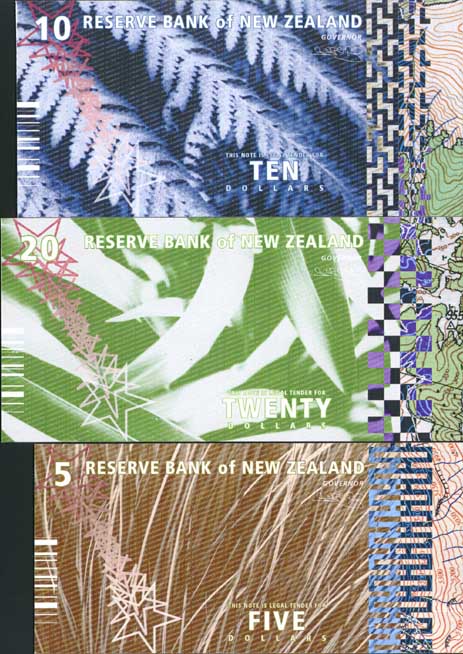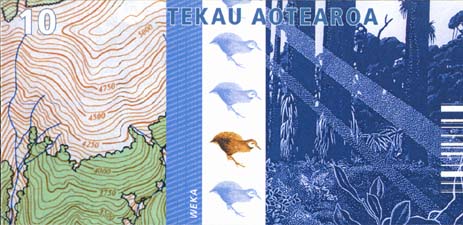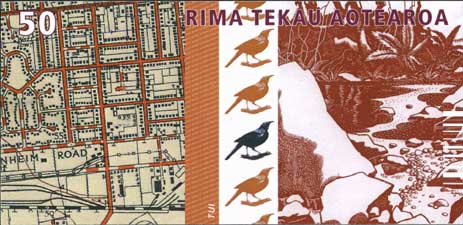Note worthy
Spencer Levine redesigns New
Zealand's banknotes, though the concepts might never see production
WHEN New Zealand switched from paper to polymer banknotes,
it was a step forward against counterfeiters. The new notes
were tougher to reproduce, had raised lettering to aid the blind,
and would last longer. However, stylistically, they fell short
of their predecessors. Culturally, too, there were problems
with the notes. Despite their relative novelty, they seemed
ripe for a redesign.
The concerns drove Spencer Levine to redesign
the notes for his final student project at the National College
of Design & Technology in Wellington. Levine researched
the history of banknotes worldwide, including security concerns
and the New Zealand design language. Swiss banknotes offered
particular inspiration. Late in 1999, Levine�s designs were
completed and make their first published appearance here in
CAP. Levine also took the opportunity to look at the
security of the banknotes and improve on them with the latest
techniques.
The polymer notes currently in circulation
had committed typographic faux pas, not least its mixing
of Avant Garde and Frutiger. There should have been some consistency
in the specifying of type, rather than mixing geometric and
humanist categories. While banknotes must be contemporary if
they are to have popular acceptance, they must also have an
air of dignity. Despite famous New Zealanders and HM Queen Elizabeth
II appearing on them, the design problems cheapen the look of
the notes.
The presence of the Queen outraged and delighted:
monarchists see the need for New Zealand to remain tied to the
Commonwealth; others do not see Her Majesty as being a New Zealander,
though constitutionally she is the Queen of New Zealand and
acts as head of state.
Levine confronted these issues head-on and
also remedied the current notes� ignorance of the Maori language.

Above:
This plate shows three of Levine's five designs for the notes.
The existing sizes have been kept, while the tukutuku panel
acts as a security feature as well as paying respect to New
Zealand's indigenous Maori culture.
New Zealand is known for its environmental
consciousness: visually it is one of the most spectacular countries.
Says Levine, �Our land is host to a wide and diverse range of
life�some unique to New Zealand, some introduced from overseas.
Regardless of origin, it is this diversity which makes our country
ours.
�We share our land with everything that lives
on it. Aside from the ever-increasing amount of people choosing
New Zealand as home, we co-exist with plants, birds, animals
and also the physical land beneath our feet. In under 270,000 km�
we host an amazing array of land types�mountains, beaches, forests,
glaciers, volcanoes and lakes, as well as bustling cities.�
Levine played on these ideas as well as the
social elements of the country. New Zealand is not generally
known for personalities. Though they exist, New Zealanders tended
to be prouder of their nation rather than their heroes.
�We are known as an ecoconscious people, and
with good reason. We have always welcomed good ecological policy,
we are keen recyclers and will usually take a "greener"
option if offered.
�Like the land we live on, we are forever
growing in many directions, and like the land, share unearthed
mystery.�
A series of banknotes�$5, $10, $20, $50 and
$100�was created to replace each of the notes used by New Zealand.
Each note is representative of one area, using topographical
maps, that area�s birds and plants, and a Maori tukutuku panel
carefully researched with consultation with native groups. The
stars from the New Zealand flag also appear in stylized form.
Importantly, Levine�s notes are bilingual, with English and
Maori (the two official languages) present.

Above:
The reverse of Levine's $10 design shows the use of Maori for
the amount and country as well as the Maori name for the native
bird that appears. Below: A more urban element is introduced
into the $50 design.

Security
Levine�s designs are meant to appear on polymer,
not paper, and security features have been built in. They are,
to lessen confusion, at the same size as the existing ones,
while he has tried to keep consistency with colour, although
changing some of the notes for greater differentiation.
Microprinting reading �Reserve Bank of New
Zealand�, the official note issuer of the nation, is on the
plant image and the topographical map. Microprinting also appears
on the coloured strip, which contains foil "sandwiched"
inside the note.
Bar codes have been used, replacing serial
numbers. Levine envisages this technique replacing older OCR
technology. The bar code is at the same place on each side of
the note.
The tukutuku panel uses colour-shifting ink,
allowing it to blend into the paper when viewed from one angle,
and inverting the colours when viewed at another.
Conclusion
Overall, Levine�s notes solve the problems
associated with the current series. There are areas where he
would like to see developments, not least the development of
an indigenous typeface. Since a suitable condensed sans serif
did not exist at the time, Levine chose Frutiger Condensed as
a monotone typeface that stood up well to the differing patterns
on each note.
The design is well balanced, with an elegance
not found in the current New Zealand banknotes. There is a hint
of Swiss modernism while remaining firmly grounded in New Zealand
culture. Because of Levine�s use of New Zealand elements in
this study, they could not be mistaken easily for the currency
of any other nation.
There does not seem to be much chance of the
notes being officially adopted at this stage. New Zealand�s
polymer banknotes were a recent introduction and a change at
this point would be seen to be a waste of taxpayer funds. Security-wise,
the current notes are sufficient, although Levine�s developments
do in theory take the fight against counterfeiters into the
future by many years.
It could upset the continuity of the current
series. Finally, the poor state of the New Zealand economy may
prevent the costly introduction of new designs, no matter how
great an improvement they may be.
Levine graduated from the College and is now
a successful designer at the Wellington design firm Native Ltd.

Home |
Contents | Features
Your feedback is welcome
[an error occurred while processing this directive]